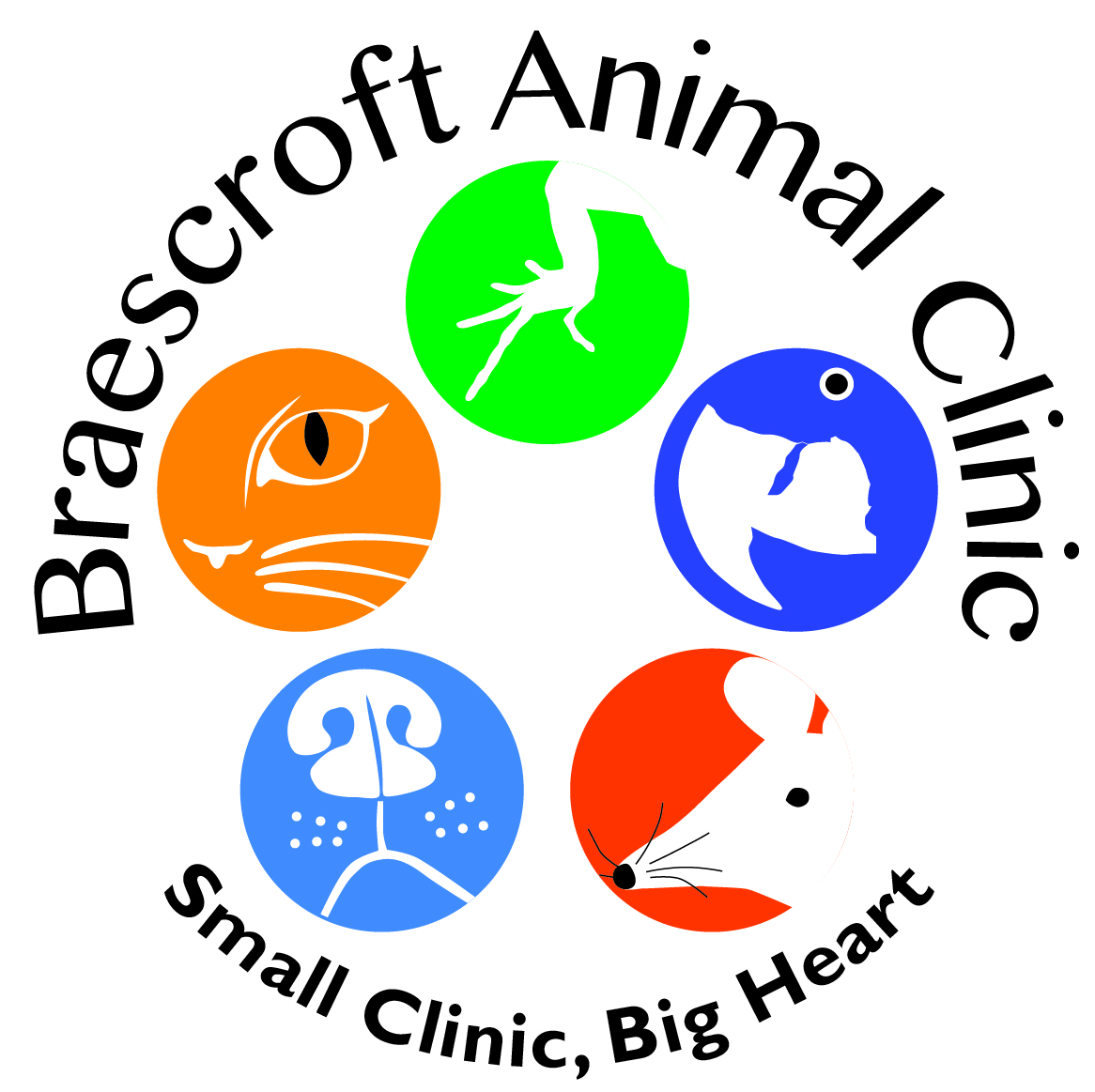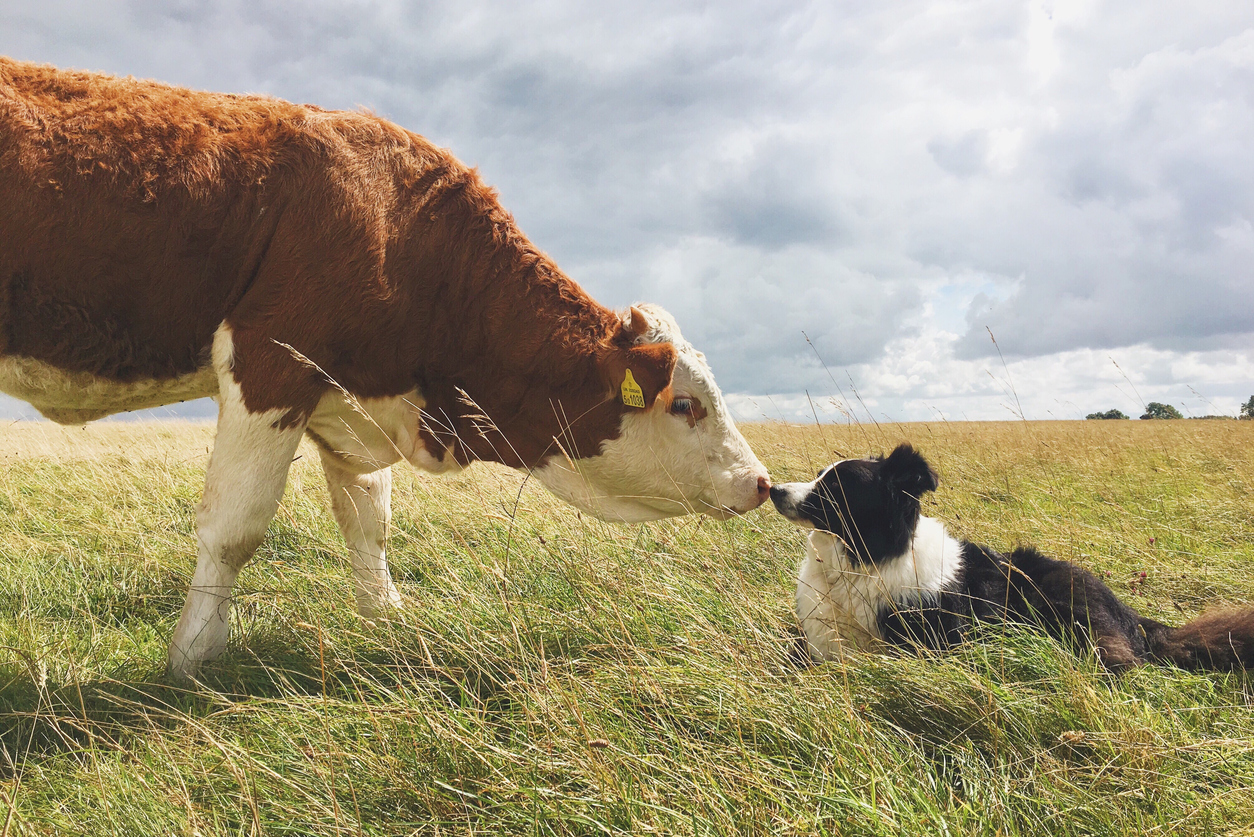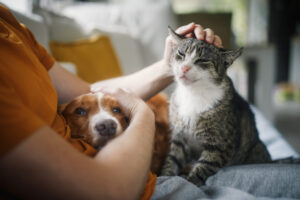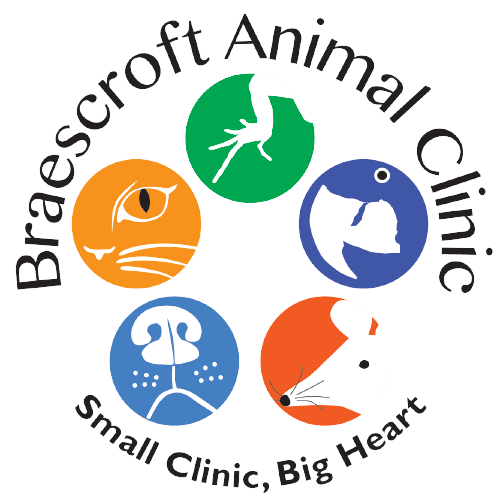At Braescroft Animal Clinic in Houston, TX, we care for pets and livestock of all kinds—from cats and dogs to backyard chickens, horses, rabbits, reptiles, and goats. While animals enrich our lives, they can sometimes carry diseases that are transmissible to people. We call them zoonotic diseases and understanding them helps protect the health of both animals and humans.
What Are Zoonotic Diseases?
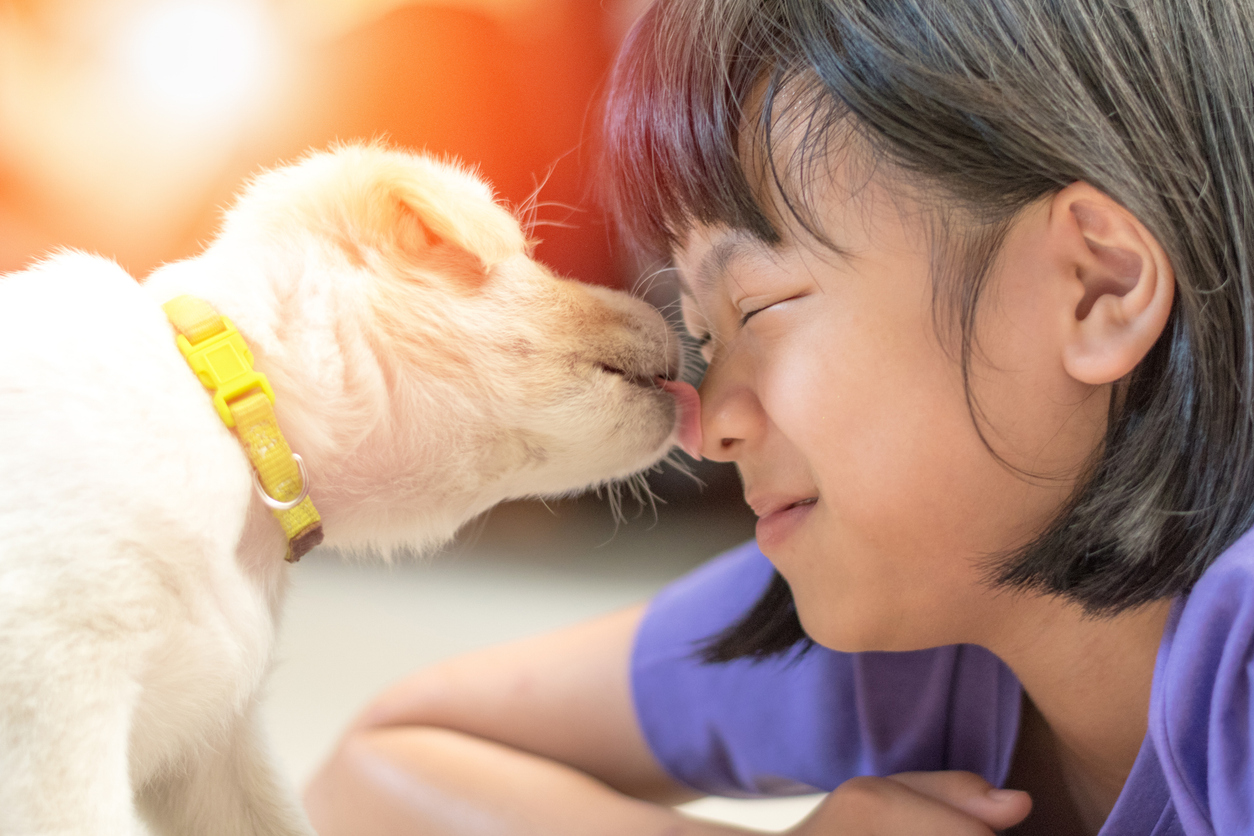
Zoonotic diseases are infections that can be passed between animals and humans. They may spread through contact with saliva, feces, urine, fur, feathers, skin, or contaminated environments. Some zoonotic diseases are mild, while others can cause serious illness—particularly in young children, seniors, pregnant women, and people with weakened immune systems.
Braescroft Animal Clinic is committed to helping you prevent zoonotic diseases in pets and farm animals through education, hygiene practices, and proper veterinary care.
Zoonotic Diseases in Dogs and Cats
- Roundworms & Hookworms (Toxocariasis)
- Symptoms in Animals: Pot-bellied appearance, vomiting, diarrhea, poor growth, visible worms in stool. Adults may be asymptomatic.
- How Animals Get It: Ingesting contaminated soil or feces, or nursing from an infected mother.
- How Humans Get It: Ingesting parasite eggs from contaminated soil, pet fur, or feces.
- Symptoms in Humans: Skin rashes, eye inflammation, cough, and rare organ damage.
- Ringworm (Fungal Infection)
- Symptoms in Animals: Circular hair loss, crusty or scaly skin, itching.
- How Animals Get It: Contact with infected animals, humans, or contaminated objects.
- How Humans Get It: Direct contact with infected skin, fur, bedding, or grooming tools.
- Symptoms in Humans: Red, itchy, ring-shaped rash.
- Giardia (Giardiasis)
- Symptoms in Animals: Diarrhea, weight loss, gas, greasy stools.
- How Animals Get It: Drinking contaminated water or contact with infected feces.
- How Humans Get It: Contact with contaminated water, pet feces, or fur.
- Symptoms in Humans: Diarrhea, cramps, nausea.
- Leptospirosis
- Symptoms in Animals: Vomiting, fever, muscle pain, jaundice, kidney/liver failure.
- How Animals Get It: Contact with infected urine, contaminated water, or rodent-infested environments.
- How Humans Get It: Exposure to infected urine or contaminated water.
- Symptoms in Humans: High fever, vomiting, red eyes, liver or kidney damage.
- Cat Scratch Disease (Bartonellosis)
- Symptoms in Animals: Usually asymptomatic in cats.
- How Animals Get It: Spread among cats through fleas.
- How Humans Get It: Scratches, bites, or saliva from infected cats.
- Symptoms in Humans: Swollen lymph nodes, fatigue, fever.
- Rabies
- Symptoms in Animals: Behavior changes, aggression, excessive salivation, paralysis.
- How Animals Get It: Bites from infected animals.
- How Humans Get It: Bite or saliva exposure from an infected animal.
- Symptoms in Humans: Flu-like symptoms, confusion, paralysis, and death if untreated.
Zoonotic Diseases in Backyard Chickens & Poultry
- Salmonella
- Symptoms in Animals: Often none; sometimes diarrhea or reduced egg production.
- How Animals Get It: Exposure to contaminated feed, water, or feces.
- How Humans Get It: Handling birds, eggs, droppings, or contaminated surfaces.
- Symptoms in Humans: Fever, diarrhea, abdominal cramps.
- Avian Influenza (Rare)
- Symptoms in Animals: Sudden death, respiratory signs, facial swelling.
- How Animals Get It: Contact with infected wild birds or contaminated surfaces.
- How Humans Get It: Contact with infected birds or droppings.
- Symptoms in Humans: Coughing, fever, respiratory illness.
- Campylobacter
- Symptoms in Animals: Rarely show symptoms; asymptomatic carriers.
- How Animals Get It: Contaminated feed, water, or fecal contact.
- How Humans Get It: Handling live birds or raw poultry.
- Symptoms in Humans: Diarrhea (often bloody), fever, cramps.
Zoonotic Diseases in Horses
- Ringworm
- Symptoms in Animals: Circular patches of hair loss, scaly skin.
- How Animals Get It: Contact with infected animals or shared equipment.
- How Humans Get It: Touching infected skin or items like saddles or brushes.
- Symptoms in Humans: Red, itchy, circular rash.
- Rabies
- Symptoms in Animals: Behavior changes, incoordination, difficulty swallowing.
- How Animals Get It: Bites from infected wildlife.
- How Humans Get It: Bite or saliva contact (extremely rare from horses).
- Symptoms in Humans: Neurological symptoms, death if untreated.
- Leptospirosis
- Symptoms in Animals: Eye inflammation, abortion in pregnant mares, fever.
- How Animals Get It: Exposure to urine-contaminated water or soil.
- How Humans Get It: Contact with infected urine, water, or bedding.
- Symptoms in Humans: Fever, vomiting, muscle pain, kidney/liver damage.
Zoonotic Diseases in Exotic Pets (Birds, Rabbits, Reptiles, Pocket Pets)
- Salmonella (Reptiles & Amphibians)
- Symptoms in Animals: Often none—they can carry Salmonella, but reptiles and amphibians are typically not affected by it.
- How Animals Get It: Naturally present in intestinal tract.
- How Humans Get It: Handling animals or contaminated enclosures.
- Symptoms in Humans: Diarrhea, fever, cramps.
- Psittacosis (Parrot Fever)
- Symptoms in Animals: Eye/nasal discharge, breathing issues, lethargy.
- How Animals Get It: Inhaling or ingesting bacteria in dried droppings.
- How Humans Get It: Inhaling dust from infected droppings or feathers.
- Symptoms in Humans: Fever, chills, respiratory infection.
- Tularemia (Rabbits)
- Symptoms in Animals: Fever, lethargy, swollen lymph nodes, sudden death.
- How Animals Get It: Insect bites, contact with infected wildlife.
- How Humans Get It: Handling infected rabbits, ticks, or contaminated water.
- Symptoms in Humans: Fever, swollen lymph nodes, skin ulcers.
Zoonotic Diseases in Farm Animals (Goats, Sheep, Cattle, Pigs)
- Q Fever
- Symptoms in Animals: Often none; may cause abortions.
- How Animals Get It: Contact with contaminated birthing fluids, feces, or dust.
- How Humans Get It: Inhaling dust or contact with birthing materials.
- Symptoms in Humans: Fever, fatigue, pneumonia.
- Brucellosis
- Symptoms in Animals: Abortions, infertility, joint swelling.
- How Animals Get It: Contact with infected placentas, milk, or fluids.
- How Humans Get It: Handling infected tissues or consuming raw dairy.
- Symptoms in Humans: Fever, joint pain, fatigue.
- Leptospirosis
- Symptoms in Animals: Jaundice, abortion, reduced milk production.
- How Animals Get It: Drinking contaminated water or exposure to infected urine.
- How Humans Get It: Contact with infected urine or contaminated water.
- Symptoms in Humans: Fever, vomiting, liver/kidney issues.
- Ringworm
- Symptoms in Animals: Hair loss, crusty skin, scabs.
- How Animals Get It: Contact with infected animals or barn surfaces.
- How Humans Get It: Touching infected skin or contaminated tools.
- Symptoms in Humans: Red, itchy, ring-shaped rash.
How to Prevent Zoonotic Diseases
Zoonotic diseases may seem alarming, but you can help prevent them with a few key habits and responsible animal care. Here is how you can help protect your household and your animals:
Hygiene
- Wash hands thoroughly after touching animals, pet food, waste, cages, bedding, or tools.
- Wear gloves when cleaning litter boxes, coops, stalls, or during animal births.
- Teach children to wash their hands and avoid putting fingers near their mouths after touching animals.
Waste Management & Environment
- Pick up animal waste daily and dispose of it properly.
- Clean and disinfect tools, grooming supplies, and food bowls regularly.
- Avoid letting pets or livestock drink from puddles, ditches, or stagnant water sources.
- Keep animal housing clean, dry, and well-ventilated.
- Isolate sick animals and consult your veterinarian promptly.
Wildlife & Pest Control
- Keep rodents and wildlife away from barns, feed, and enclosures.
- Don’t feed wild animals or allow pets to interact with them.
- Report any unusual bird deaths or sick wildlife to your local animal control or agriculture department.
Safe Animal Handling
- Avoid rough play to reduce the risk of bites or scratches.
- Don’t allow pets to lick your face or open wounds.
- Supervise young children around animals and discourage kissing or hugging pets.
- Use protective clothing when working with birthing fluids or potentially infected animals.
Veterinary Care
- Keep all pets and livestock up to date on vaccines, especially rabies and leptospirosis.
- Follow your veterinarian’s deworming and parasite prevention schedule.
- Have new or sick animals examined before introducing them to your home or herd.
Your Houston Partner in Animal and Family Health
At Braescroft Animal Clinic, we proudly serve Houston-area families and farms with compassionate, knowledgeable care for dogs, cats, exotic pets, poultry, horses, and livestock. Whether you need help with parasite prevention, vaccinations, or advice on zoonotic disease risk, we are here to help.
9643 Hillcroft St.
Houston, TX 77096
